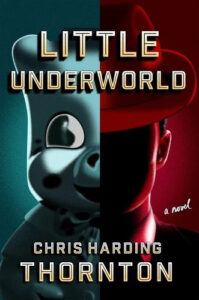As a writer of narratives, I’m leery of them. Especially historical ones. I’m not skeptical of events; I’m skeptical of wording and connective tissue. Of the clean causality.
Take the St. Valentine’s Day Massacre. (Seven men murdered in a garage, no one was ever convicted). Because speculating on whodunits is great fun, and because politicians at the time did what they do—spun the events to their advantage—and because that advantage played into anti-gangland sentiment that eventually, indirectly resulted in a RICO case against Al Capone (who was never connected, materially, to the murders), I wasted several hours of my youth waiting for Geraldo to open an empty vault.
And then I learned just enough about chaos theory to create problems in my brain. Eleven or twelve years ago, I asked a very bearded and studious-looking professor, an author of historical narratives, about those problems. I figured he’d taught the answers in introductory courses, so I asked: How do history writers wrestle with knowing they’re streamlining a millisecond’s reaction to every variable that came before it? How do they omit and create seamless causality while trying to be true?
I don’t remember the response. I remember the beard and the glare off the historian’s glasses, radiating silent but distinctly violent disdain. I walked away sure of only this: Historians possess the power to obliterate you completely. Omit you from having existed.
I’d stick to fiction: the warm, pillowy comfort of plausible deniability.
Then I wound up writing a book that needed a historical fiction disclaimer, and here I am. Writing as nonfictionally as I can make words.
Before another sentence, understand that I am a simple yahoo—a fiction writer with no postsecondary education in history. My only provenance stems from obsessively researching genealogy. I’m sure the tendency came from growing up with eleven living, blood-related grandparents (parents of parents of parents of parents).
One of them, a great-grandfather, fascinated me. They all did, but he was fiery, a bit strange, and he had mesmerizing taste.
Great-Grandpa bred horses before I was born and had a small den with loud but somehow matching red and green leather chairs and sofa, all embroidered with lassos or horse heads, all with wood arms shaped like wagon-wheels. Plastic horses—that were not toys—stood on the end tables beneath lamps whose shades were celluloid Western landscapes. Great-Grandpa listened to Hank Williams and Jim Reeves and Bob Wills. Not long before he died, when I was in high school, he said a coyote had been visiting each night, to eat junebugs under the lamppost between his and my grandparents’ houses.
Grandma, his daughter I’d lived with next door, always said that whenever the old man finally died, he’d bolt up in the coffin and scream that she’d put him in the wrong shirt.
In the end, he didn’t. But he was mercurial, in that particular way a person with many secrets can be mercurial. I know only one of those secrets, and I won’t spill it because Grandma taught me not to be a snitch.
So, instead, I’ll tell an innocuous but illustrative anecdote: When my mother, pregnant with me, needed a job, Great-Grandpa apparently marched her into a regionally famous Omaha, Nebraska furniture store and demanded to speak with its regionally famous owner, a woman who was a lively character, one who exuded friendliness while commanding respect and instilling fear. She was not a person to whom one issued demands. And I suppose if what I’ve been told is correct, Great-Grandpa technically didn’t. He said a terse, “This is my granddaughter. She needs a job.” No “please,” no “thank you,” no “I would really appreciate it if.” That was it. And my mother had a job.
Maybe a favor was owed. Maybe a sensitive matter was known. How the store owner and Great-Grandpa had developed that rapport, I don’t know. I can’t say much for certain because he did not leave much of a paper trail. Or if he did, I suppose Grandma would’ve burned it. She once warned me, “Unless it deals with money, never—ever—put it in writing.” (I’m aware of the irony, yes.)
From what I have since gathered, this paper trail thing was a hard-learned family lesson. The voice of Great-Grandpa’s grandpa can be read in an old Supreme Court case (he was in a little trouble), and a couple of Great-Grandpa’s uncles were widely covered in local and regional newspapers. One was an ice man who was arrested at least four times I know about, twice for manslaughter. Neither was a disproven accusation. But he never spent more than a few nights in jail, and, somehow, the state historical society doesn’t have his booking photo.
Neither does the society have a booking photo of his brother Jim, but that’s easily explained. Jim demanded its return during a court case completely unrelated to the booking photo. Like his father before him, Jim frequented court. When he wasn’t there to punch a judge or appear on larceny charges, he was a truant officer or cop. He worked at the courthouse in the first decade of the 1900s, too, until he may or may not have aided in the escape of four prisoners. He ran for low-level political offices, seemingly with the intention of splitting votes. Eventually, he operated his own private investigation agency. On the whole, the record suggests Jim had a vendetta against powerful people, which may or may not have been why he was committed to the State Hospital. (The Insanity Board was comprised of two political appointees and one doctor who seems to have been a real piece of work.) Jim died in the custody of the hospital roughly two years later. His brother the manslaughterer died about three years after that, all signs suggesting he was a manslaughter victim himself, but the coroner declined to pursue an inquest.
Many people, for good reason, might avoid parading a particularly gnarled branch of family tree, but against sage advice, I decided to write a novel based on Great-Grandpa’s uncles—not about them—based on them. The end result was Little Underworld.
I’d been researching for years already, but the book was a new excuse, and at a point, I’d reread so many newspapers, my dreams were set in 1928. I needed to come up for air. I needed to see some shape that wasn’t laser-focused on the daily creep of time.
I turned to what is probably the most influential book concerning the history of Omaha, Dr. Orville D. Menard’s River City Empire: Tom Dennison’s Omaha. Menard was widely loved as a great friend and mentor. I wish I’d had the chance to know him. I’d read his book once for fun, but as often happens with fun, I’d retained little I hadn’t heard or read elsewhere. River City Empire is a resource in books and newspapers, on the website of the state historical society, and, yes, throughout Wikipedia.
I say the book concerns Omaha history because it’s not a history book. Menard says that in the preface: “A history of Omaha is not provided here, for such an endeavor is beyond the intent or purpose.”
Instead, Menard was a political science professor. He transposed the theory of “political bossism” onto Omaha from the period of 1900-1933. The concept is what it sounds like—somebody (usually not an elected official) controls a city’s political power. Kansas City was known for Tom Pendergast; New York for Boss Tweed; Atlantic City for Nucky Johnson. River City Empire posits that Omaha had Tom Dennison.
Now, Menard didn’t concoct this notion that Dennison ran Omaha. I could, with fair confidence, point to a few people who did concoct it, but I live in a place where descendants of powerful people are still around, and I’m the relative of a manslaughterer who was almost definitely manslaughtered. I don’t have much snitch-latitude.
Dennison had long been cast as a political boss (when he wasn’t suing newspapers out of existence for libel). He was a thin, tall gambler who wore a bowler and a chunky diamond pin in his necktie—he looked the part. And he was involved in politics. That’s shady. Granted, nearly everyone involved in Omaha politics during (and before and after) Dennison’s alleged reign was shady, but there seems to be ample evidence he pulled some antics—maybe registered dead voters, probably registered voters whose addresses did not exist.
Where things get tricky in Menard’s narrative—and much, much darker—is the possible degree of Dennison’s involvement in a mob’s racist, brutal murder of a man named Will Brown in September 1919.
Will Brown was a black man accused of raping a white woman. While he was being held in the county courthouse, the mob set fire to the building. When Brown was turned over to them, they lynched, shot, burned, and dragged him through the streets.
If you read about the murder, right here, you’ll find most writers note that a source said the accusation was untrue, that Brown was physically disabled. He was incapable of attacking anyone.
That’s horrifying but also immaterial. Whether he did or didn’t commit a crime, a mob, comprised of thousands of people, burning a courthouse and demanding a man be turned over to them to be lynched, shot, burned, dragged, and photographed for posterity ranks as a fucking atrocity.
Menard was (and was not) careful to avoid blaming Dennison directly for the murder. He writes, “There is no firm evidence the Dennison [political] machine actually instigated the particular events.”
But, Menard does strongly suggest that Tom Dennison had such far-reaching control (and omniscience, it seems) that he’d actually thrown the preceding 1918 city election to his political opponents, thereby stoking what could, apparently, end only in the horrific nightmare of a person’s brutal murder. Menard quotes a nameless newspaper editor as recalling “a statement alleged to Dennison early in the campaign: ‘I think we better let the bastards have it their way for awhile [sic]; let’s lie low this next election—they’ll be glad to see us back.’”
That reads like two things to me: a game of telephone and a trick of hindsight.
But where I was ripped from the page so completely that I fact-checked Menard’s sources for months was when I came across a small, uncontroversial passage about Omaha Mayor James Dahlman.
As the story goes, Mayor Dahlman was controlled by criminal mastermind Tom Dennison and was therefore elected continuously from 1900-1930 (aside from 1918-1920, when an unnamed newspaper editor suggested Dennison decided to teach the city a lesson). Menard writes this:
“When the mayor needed transportation, he took a taxi or rode the streetcar. He neither owned an automobile nor accepted an official one (he said the city charter made no provision for it).”
This is not true.
And please know that, when I say something is true or not true, I say it as someone who knows narrative is a wobbly thing. We write symbols that carry meaning only because we agree on those meanings. We omit things we deem extraneous and create streamlined causality—“a temporary stay against confusion,” Robert Frost called it. Narratives are inherently imperfect constructions. But there is an actuality in the above statement. Specifically: A mayor had a car or didn’t. Dahlman did.
Unless—and I always go back to this—I am living inside the dream of a single cell of maybe an antelope or a cow. Or maybe the world has conspired to falsify hundreds of newspaper articles archived on the internet. Just for me.
If neither of those is the case, I know that Mayor Dahlman drove a city-provided car, because Great-Grandpa’s uncle Jim, the PI, was hired to tail it in 1916. As a result, the mayor was enjoined from using it. Then, six more lawsuits were brought against Dahlman and five city commissioners, demanding their ouster and repayment of money used to maintain the vehicle from 1912 through 1917, an amount alleged to be $13,716.67. During that 1918 campaign, the one Dennison allegedly threw to his political opponents, “$13,716.67” featured prominently in political ads. When Dahlman gave stump speeches throughout the city, at least one newspaper noted he didn’t address the subject.
In other words, Mayor Dahlman’s use of a city car very likely factored into his failure to win reelection. The car wasn’t the sole reason (chaos theory). But I’m willing to bet that car was one of them. That seems to make a bit more sense than Dennison’s omniscience to me. Voters who lived hand-to-mouth, and most did, likely felt betrayed by an elected official out joyriding on their dime. Especially a guy who was supposedly so beloved that a political science professor, born three years after that mayor’s death, dedicated nearly an entire chapter of a book to cleansing the mayor’s reputation. Right after associating him with an alleged criminal whose mastermind apparently far surpassed the level of Doyle’s Moriarty.
If you’ve read this far, you’re surely saying, “So? An Omaha mayor had a car, and a poli-sci professor wrote a book. Why would that matter to anyone living in the here and now, especially outside of Omaha, Nebraska?”
Because a theory, one with a piece that is patently not true, is now referenced as fact. That is what narrative can do. Dr. Menard may have never intended his book to serve as a history, but he might as well have carved it into stone tablets.
The big takeaway is that a very large chunk of an American city’s history, one that’s taught in classrooms and cited by sources we should be able to trust, has been boiled down to this: A crime lord and puppeteer of local politics fixed elections and controlled the media. Through brainwashing and payoffs and cronyism, he engineered a mob to storm a courthouse and brutally murder a person.
I wish it were true.
I wish that was the only possible explanation behind Will Brown’s murder. I wish I could believe a single puppeteer was pulling strings. I wish I could know that a collective of human beings, with consciousnesses, sensations, memories, even love for others in their lives—couldn’t do what they did.
But I’m fairly sure they did.
And I’m fairly sure if we keep saying they didn’t, not on their own, that is not great.
If you’re curious about how the narrative ends—the Omaha one—justice saved the day. Not in the death of Will Brown—no one was ever convicted. But later, in 1932, prosecutors claimed the city’s illegal liquor, prostitution, and gambling were controlled by a “syndicate,” a conspiratorial effort, headed by Tom Dennison. The lengthy trial effectively dismantled Dennison’s political machine.
(Except no one was convicted in that trial, either. No proof.)
Of course, one can’t let these things stop a good story.
***


















